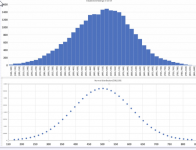In another thread some are discussing what fraction of players
--might have once, or
--are capable of, or
--regularly
run 100 balls in straight pool
and the discussion brings home the difficulty of deciding who is a "player." Is it someone who has picked up a pool cue once in the last 6 months? Someone with an established Fargo Rating? The answer will depend tremendously on this choice.
Here are a few stats from the FargoRate database that illustrate the problem. The bolded part refers to players with an established rating, though outside the somewhat arbitrary choice of 200 as "established, " it is clear there is nothing special here. Better players play more and are more likely to have games that made it into our database. As more players come in, these distributions will shift.
The number of people with 50 or more games is 72,338.
average performance rating is 463
standard deviation is 121, meaning two thirds are between 342 and 584
1.9% are over 700
The number of people with 100 or more games is 47,423.
average performance rating is 479
standard deviation is 115, meaning two thirds are between 364 and 594
2.2% are over 700
The number of people with 200 or more games is 26,477.
average performance rating is 500
standard deviation is 109, meaning two thirds are between 391 and 609
3.0% [785 players] are over 700
The number of people with 400 or more games is 13,205.
average performance rating is 523
standard deviation is 105, meaning two thirds are between 418 and 628
4.4% [ 589 players] are over 700
The number of people with 800 or more games is 5411.
average performance rating is 550
standard deviation is 103, meaning two thirds are between 447 and 653
7.5% [ 409 players] are over 700
--might have once, or
--are capable of, or
--regularly
run 100 balls in straight pool
and the discussion brings home the difficulty of deciding who is a "player." Is it someone who has picked up a pool cue once in the last 6 months? Someone with an established Fargo Rating? The answer will depend tremendously on this choice.
Here are a few stats from the FargoRate database that illustrate the problem. The bolded part refers to players with an established rating, though outside the somewhat arbitrary choice of 200 as "established, " it is clear there is nothing special here. Better players play more and are more likely to have games that made it into our database. As more players come in, these distributions will shift.
The number of people with 50 or more games is 72,338.
average performance rating is 463
standard deviation is 121, meaning two thirds are between 342 and 584
1.9% are over 700
The number of people with 100 or more games is 47,423.
average performance rating is 479
standard deviation is 115, meaning two thirds are between 364 and 594
2.2% are over 700
The number of people with 200 or more games is 26,477.
average performance rating is 500
standard deviation is 109, meaning two thirds are between 391 and 609
3.0% [785 players] are over 700
The number of people with 400 or more games is 13,205.
average performance rating is 523
standard deviation is 105, meaning two thirds are between 418 and 628
4.4% [ 589 players] are over 700
The number of people with 800 or more games is 5411.
average performance rating is 550
standard deviation is 103, meaning two thirds are between 447 and 653
7.5% [ 409 players] are over 700

